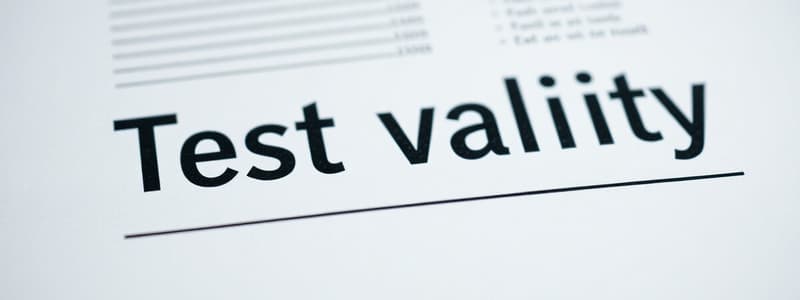Podcast
Questions and Answers
A researcher develops a new survey to measure anxiety. To ensure content validity, which aspect should they prioritize?
A researcher develops a new survey to measure anxiety. To ensure content validity, which aspect should they prioritize?
- Comparing the survey results to an established anxiety measurement tool administered simultaneously.
- The font size and spacing of the survey questions to minimize respondent distraction.
- Administering the same survey to the same group of people at two different times and correlating the results.
- Ensuring that the survey questions comprehensively cover all facets of anxiety as a psychological construct. (correct)
Which type of validity is most directly concerned with how well a test forecasts future performance or behavior?
Which type of validity is most directly concerned with how well a test forecasts future performance or behavior?
- Construct Validity
- Concurrent Validity
- Face Validity
- Predictive Validity (correct)
A school psychologist wants to introduce a new standardized test. To determine concurrent validity, what should be done?
A school psychologist wants to introduce a new standardized test. To determine concurrent validity, what should be done?
- Administer the test twice to the same group of students, separated by a significant time interval.
- Have multiple experts review the test questions to ensure they appear relevant.
- Administer the new test alongside an existing, validated test on the same topic and compare the results. (correct)
- Compare the test scores of students from different schools to ensure consistency.
A researcher uses a personality test to measure introversion. If the test truly measures the theoretical concept of introversion, it is said to have high:
A researcher uses a personality test to measure introversion. If the test truly measures the theoretical concept of introversion, it is said to have high:
Which of the following scenarios exemplifies the assessment of interrater reliability?
Which of the following scenarios exemplifies the assessment of interrater reliability?
A professor gives two slightly different versions of an exam to their class. What type of reliability is most appropriately measured in this situation?
A professor gives two slightly different versions of an exam to their class. What type of reliability is most appropriately measured in this situation?
To measure split-half reliability, what is the process that should be followed?
To measure split-half reliability, what is the process that should be followed?
Which of the following best illustrates test-retest reliability?
Which of the following best illustrates test-retest reliability?
A researcher modifies the font and spacing of a questionnaire to make it more user-friendly. Which aspect of validity is being addressed?
A researcher modifies the font and spacing of a questionnaire to make it more user-friendly. Which aspect of validity is being addressed?
A fitness test is designed to measure cardiovascular endurance. If the test consistently produces similar results each time an individual takes it, regardless of the testing environment, the test is said to have high:
A fitness test is designed to measure cardiovascular endurance. If the test consistently produces similar results each time an individual takes it, regardless of the testing environment, the test is said to have high:
Flashcards
Validity
Validity
The extent to which an instrument measures what it is intended to measure.
Content Validity
Content Validity
Whether the items of a test represent what you want to assess.
Face Validity
Face Validity
Logical validity based on the appearance of an instrument's features.
Construct Validity
Construct Validity
Signup and view all the flashcards
Criterion-Related Validity
Criterion-Related Validity
Signup and view all the flashcards
Concurrent Validity
Concurrent Validity
Signup and view all the flashcards
Predictive Validity
Predictive Validity
Signup and view all the flashcards
Reliability
Reliability
Signup and view all the flashcards
Test-Retest Reliability
Test-Retest Reliability
Signup and view all the flashcards
Interrater Reliability
Interrater Reliability
Signup and view all the flashcards
Study Notes
Validity
- Validity describes the extent to which an instrument measures what it is intended to measure.
Content Validity
- Content validity assesses if the individual test items represent the concept being measured.
- Face validity is a type of content validity.
Face Validity
- Also known as logical validity, it analyzes if the instrument uses a valid scale.
- Researchers determine face validity by examining the instrument's features.
- These include font size, spacing, paper size, and any other details that might distract test-takers.
Construct Validity
- It describes the extent to which a test measures a theoretical construct or concept.
Criterion-Related Validity
- It assesses an instrument's validity by comparing its scores to another criterion known to measure the same trait or skill.
Concurrent Validity
- It measures the extent to which results of a test align with an established test taken at the same time.
Predictive Validity
- It describes the extent to which a procedure allows accurate predictions of a subject's future behavior.
Reliability
- Reliability measures the consistency of measurements.
- A reliable test produces similar scores under various conditions, situations, evaluators, and testing environments.
Test-Retest Reliability
- It implies subjects receive the same score when tested at different times.
Split-Half Reliability
- Also known as internal consistency, it indicates that a subject's scores on some trials consistently match their scores on other trials.
- This is demonstrated by comparing scores from different halves of a test.
Interrater Reliability
- It involves two independent raters observing and recording specified behaviors during the same time period.
- The raters should observe the same target behavior.
Alternate Forms Reliability
- Also known as parallel-forms reliability, it's achieved by administering two equivalent tests to the same group of test-takers.
- The items are matched for difficulty.
- The time between administrations should be as short as possible for effective measurement.
Studying That Suits You
Use AI to generate personalized quizzes and flashcards to suit your learning preferences.




